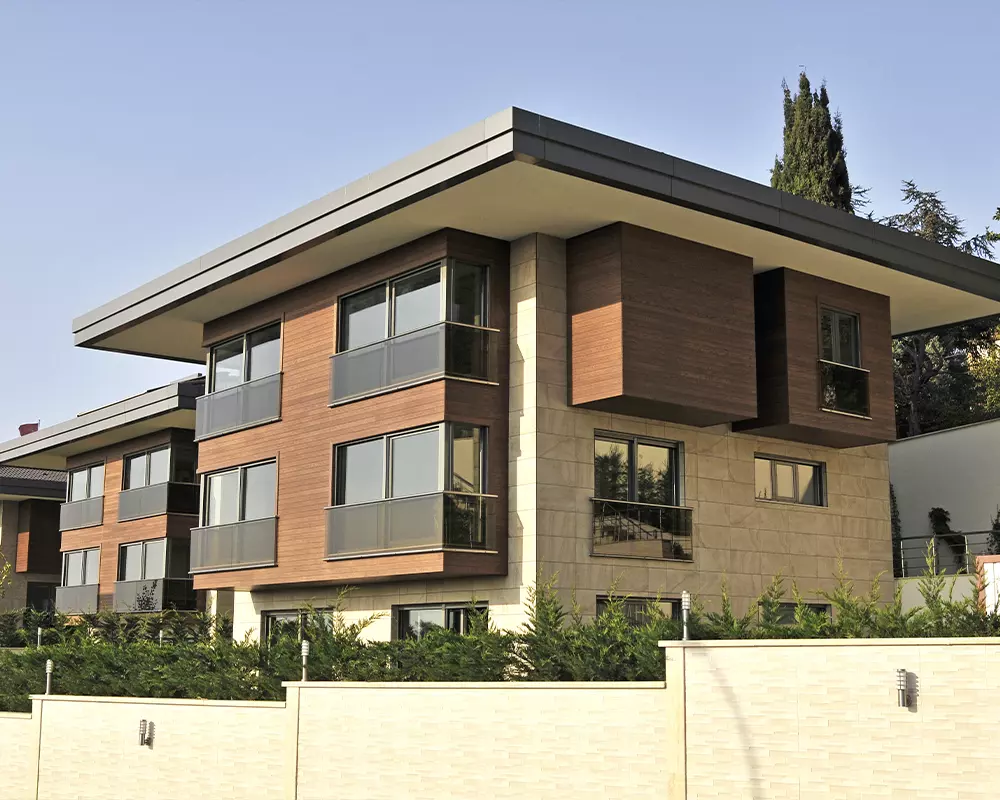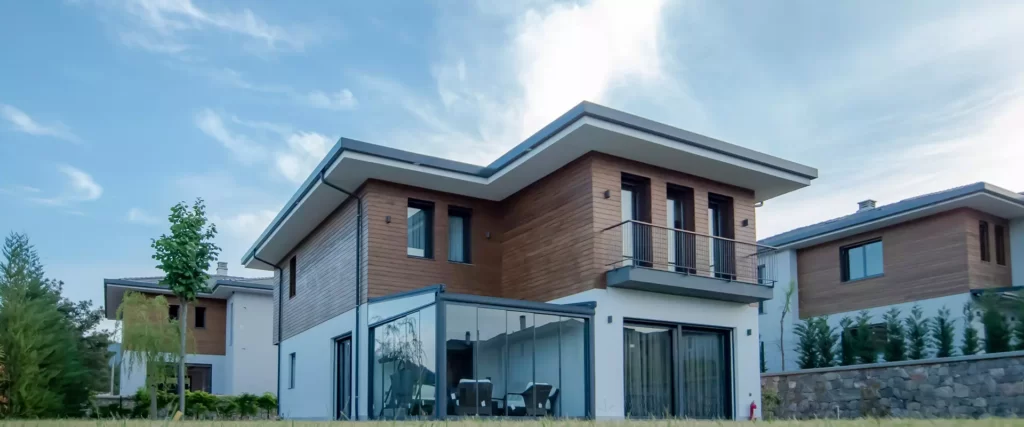Thermally modified cladding has emerged as a distinguished choice for exterior cladding that blends the natural appeal of wood with enhanced durability and resistance to weather elements. This article is a comprehensive overview of thermally modified cladding that emphasizes its cost, installation procedures, and other essential details.
What is Thermal Wood Cladding?

Thermally modified cladding is created through a thermal modification process where wood is heated at high temperatures in a controlled environment. This process significantly improves the wood’s durability and stability by permanently modifying the wood’s cells, which results in a cladding material that is aesthetically pleasing, decay-resistant, and less prone to moisture and temperature-induced damages. As an exterior cladding material, thermowood offers both longevity and a distinct natural charm.
Varieties and Styles of Thermally Modified Wood Cladding
Thermo treated wood cladding is available in various wood types, each offering unique characteristics and advantages:
Thermo Treated Pine Cladding

Thermo treated pine cladding is a popular choice due to its versatility and aesthetic appeal. Sourced mainly from Scandinavian forests, pine has a relatively low density that makes it easy to work with for a range of architectural styles. Its natural resilience and ability to withstand varying weather conditions make it a practical choice for exterior cladding. Thermowood pin cladding provides a classic look that complements both traditional and modern designs.
Thermo Treated Ayous Cladding

Thermo treated Ayous, also known as African Whitewood, is increasingly sought after for thermowood cladding. Known for its uniform texture and excellent stability, Ayous is an ideal choice for a smooth, contemporary finish. Its light color and ability to take on stains and finishes well make it a versatile option for designers and architects. Thermal Ayous also provides good resistance to decay and insects, which makes it a durable choice for exterior cladding applications.
Thermo Treated Ash Cladding

Thermo treated ash thermowood cladding stands out for its distinctive appearance and robust properties. Ashwood is appreciated for its appealing color and tight grain structure that creates a premium, knot-free finish. This hardwood is known for its strength and durability, so it is a suitable choice for areas exposed to more harsh weather conditions. Thermo modified ash cladding meets Class-1 durability requirements, to help ensure a long functional lifespan which makes it a preferred choice for high-quality cladding projects.
Installation of Thermally Treated Cladding
The installation of thermally treated cladding is a process that, while straightforward, requires attention to detail in order to ensure longevity and aesthetic appeal. The typical installation method and the specialty tools and hardware used are as follows:
1. Preparation of the Surface
Before installation, ensure that the entire surface where the cladding will be applied is clean, dry, and smooth. This might involve removing old cladding, repairing any damage to the underlying surface, and applying a waterproof membrane if necessary.
2. Setting Up Battens
Vertical battens are fixed to the wall at regular intervals. The battens provide a frame onto which the cladding boards will be attached. It’s important to use treated and durable wood for the battens in order to prevent rot and ensure a stable base for the cladding.
3. Measuring and Cutting
Thermally modified cladding boards need to be measured and cut to fit the specific dimensions of the area being clad. This requires precision tools like a circular saw or a miter saw for accurate and clean cuts.
4. Fixing the Cladding
The cladding boards are then fixed onto the battens. Depending on the design, this can be done using screws or nails.
5. Specialty Tools and Hardware:
- Power Drill: Essential for drilling pilot holes and driving screws
- Circular Saw or Miter Saw: For cutting the cladding boards to the required lengths and angles
- Level and Tape Measure: For accurate placement and alignment of the cladding boards
- Screws and Nails: Stainless steel or galvanized fittings are recommended to prevent corrosion
- Cladding Clips: Some systems use specialized clips to attach the cladding boards to the battens to allow for expansion and contraction
6. Finishing Touches

Once the cladding is installed, finishing touches such as edge trims and corner pieces can be added. These not only enhance the aesthetic appeal, they also protect the edges of the cladding from moisture and wear.
7. Sealing and Treatment
Although thermally modified wood is durable and weather-resistant, applying a sealant or wood treatment can further extend its lifespan and maintain its appearance.
It’s important to follow the manufacturer’s guidelines during installation, as improper installation can lead to issues such as warping or gaps. Professional installation is recommended for the best results, especially for complex designs or large areas.
Thermally Modified Cladding Prices
When considering thermally modified cladding, it is important to notice that some wood species will be more expensive than regular treated wood. However, there are thermo-treated wood species that have better cost-effectiveness results such as thermo Ayous and thermo pine. Typically prices will be influenced by several factors, including:
- The type of wood
- Thickness
- Finish
The price can also vary depending on the profile of the boards, with designs such as tongue and groove being pricier, as well as any pre-staining or finishing.
Even though prices might be higher at some cases, thermally treated wood offers several advantages over pressure-treated lumber:
- Its increased durability makes it more resistant to environmental wear such as rot, decay, and insect damage.
- Thermowood’s dimensional stability is also noteworthy, as it is less prone to shrinking or swelling with changes in humidity, which makes it ideal for outdoor use.
- The minimal maintenance requirements and the natural, warm aesthetic of thermowood further contribute to its appeal compared to the often green-tinted pressure-treated lumber.
Maintenance and Durability
Thermowood cladding boasts low maintenance requirements, needing only standard care to preserve its appearance and durability. To ensure optimal longevity, it is advisable to oil the lumber at least once a year, providing protection against decay and environmental elements.
While routine cleaning and periodic inspections for damage are usually sufficient, we strongly recommend a closer look at the manufacturer’s guidelines and maintenance instructions for tailored insights. This proactive approach ensures that your Thermowood cladding remains in top-notch condition, with a potential lifespan of up to 60 years in certain conditions.
Thermally Modified Wood vs. Other Cladding Materials
Compared to other materials like cedar, thermally treated wood has several advantages. Its thermal modification process enhances stability and reduces risks associated with warping, splitting, and deformation, common in traditional lumber. thermowood’s environmental sustainability also makes it a preferred choice for eco-conscious homeowners and builders.
Sourcing Thermowood Cladding

Selecting a reputable supplier for thermowood cladding is essential. Quality suppliers provide not only high-grade materials, but also valuable advice on the most suitable cladding types for various projects.


